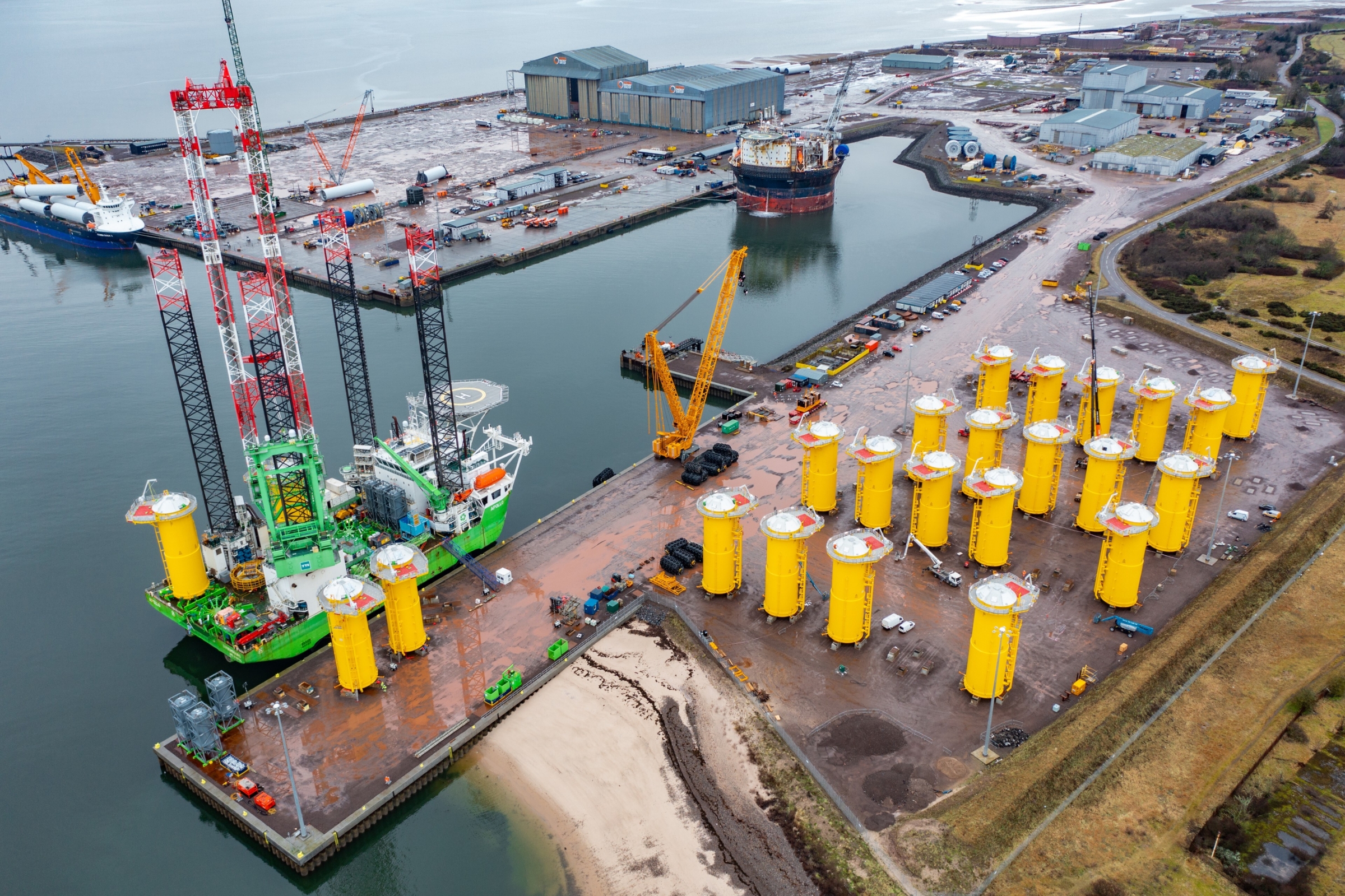
Transition piece marshaling utilized fast and efficient SPMT and crawler crane transfer method for an offshore wind farm
22 kilometers off the Scottish coast, Moray West marks the third offshore wind farm in the Moray Firth region, joining Moray East and Beatrice.
The clean energy project will help to deliver a low-cost, low-carbon electricity supply feeding up to 1.33 million homes.
Having already worked together in the past, Global Energy Group trusted Mammoet’s guidance and engineering when a planned RoRo method of offloading the TPs was no longer feasible.
Mammoet proposed transshipping the TPs onto Self-Propelled Modular Transporters (SPMTs) using a crawler crane, with its ballast supported by a separate axle line combination.
The method resulted in greater maneuverability and less downtime between lifts. It also prevented the shifting tides at the marshalling port from impacting the operation.
Smooth TP transition using SPMT and crawler crane
Mammoet’s scope for the work in this clean energy project was to receive the components at the Port of Nigg following seaborne transport, offload them onto SPMT trailers, and then drive them to a temporary storage area where pre-installation works could be performed.
Once the TPs were ready to be delivered offshore, they would be driven back to the quayside by SPMT in batches of four, to be collected and delivered to the offshore wind farm site by installation vessel.
The original plan was to drive the TPs off the vessels using SPMT transport with a TP handler attachment. However, this plan had to be altered late in the planning stage. Oliver Smith, Senior Commercial Manager at Mammoet, explains why:
“As things developed, new information about stowage plans, how the TPs were going to be set out on the delivery vessel, and the heights and the mooring arrangements meant this was no longer an option.
It came down to the loadout methodology and the load-in not aligning, with a big part of that being the fact that the vessel would be moored stern on to the quay. This meant there wasn’t enough space to get a TP handler onto the vessel and get the TPs off it.
We were able to provide solutions to change the grillage design to allow it to work, but ultimately to support a holistic approach to get the components from A to B we came up with a crawler crane solution.”
Heavy lift and transport efficiency with a tailor-made crane solution
There were two TP types: 60 units weighing around 505t, to support offshore wind turbines, and two heavier Offshore Substation Platform transition pieces (OSP) weighing around 832t.
The 60 TPs were lifted off the vessel using a LR11350 crawler crane onto a 32-line configuration of SPMT. The crane was supported by a separate 24-axle line combination, which was used to maneuver the ballast tray.
Smith explains the time-saving benefits of this method:
“It is possible to move the tray by crane, but we needed a quicker, more efficient mechanism, which is why we used SPMT transport. If you lift the tray by crane and have close to 600t worth of ballast, you must lift that block by block to relocate it. With the SPMT, once it takes the load of the ballast wagon it can move faster.”
Managing heavy lifting challenges
The TPs arrived at the port in varying numbers, ranging in batch sizes from 4 to as many as 16. This caused challenges at times, especially if there were any delays to the vessels, which had to make the long journey from the UAE to the UK, through the Suez Canal.
Much like the team had done at the start to come up with a crane solution using SPMT and crawler crane when plans altered, they were able to adapt, manage and prevent schedule changes from causing issues.
The crane solution also meant that the offloading stage wouldn’t be negatively impacted by the tides, as the components were lifted off the vessel instead of being rolled off.
The strong working relationship that Mammoet has with the customer is one that has been built on years of trust, having performed several successful heavy-lift and transport projects at the same site, including for Seagreen Offshore Wind Farm.
“Our working relationship is one that has been built on years of trust, having performed previous successful heavy-lift and transport projects at the same site, including for Seagreen Offshore Wind Farm. We have a good working relationship with the port and have been able to work together in a very complimentary fashion.” closes Smith.
“Because we have good experience of each other, we can work well as a team to deliver projects safely and efficiently and ultimately give the end client the benefit of that good working relationship.
I think its success was a testament to the start of the project, when we worked closely together, and offered transparent engineering feedback that enabled us to change the planning at the last minute to use the crane and complete the project to a faster schedule.”